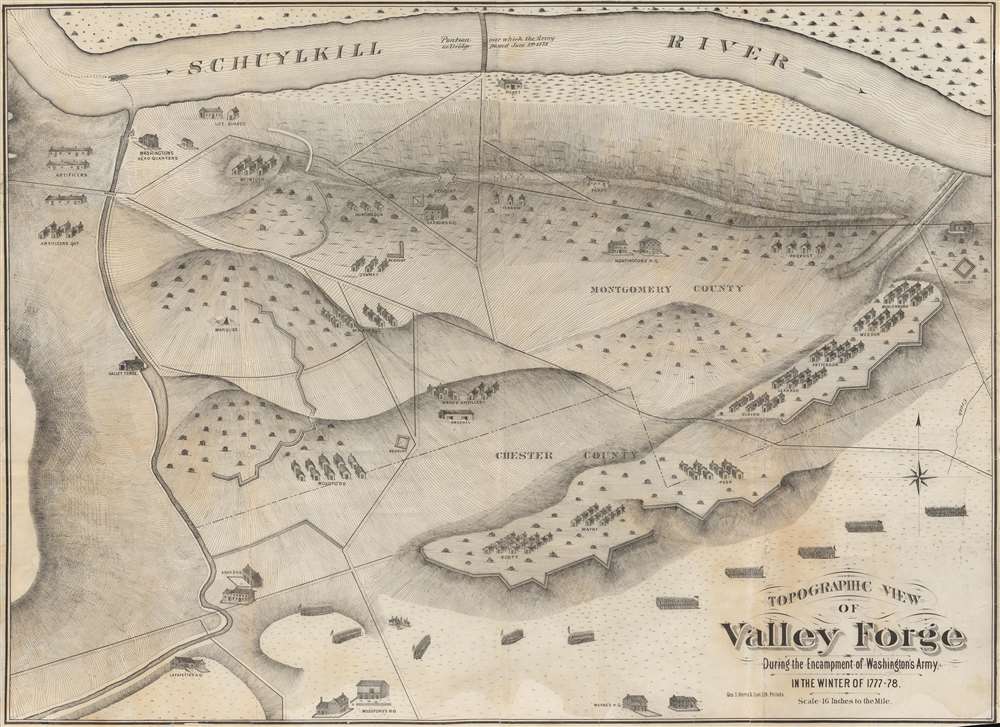This item has been sold, but you can get on the Waitlist to be notified if another example becomes available, or purchase a digital scan.
1877 Harris View Map of Valley Forge, Pennsylvania, during Washington's Encampment
ValleyForge-harris-1877
Title
1877 (undated) 22 x 30.25 in (55.88 x 76.835 cm)
Description
Valley Forge the Army Encampment
During the winter of 1777 - 1778, George Washington and the Continental Army wintered at Valley Forge, Pennsylvania. Washington chose Valley Forge due to its proximity to Philadelphia (captured by the British in 1777) and defensible location on a high plateau. From December 19, 1777, through June 19, 1778, soldiers built between 1,600 and 2,000 log huts for the officers and enlisted men.Valley Forge as National Myth
The winter at Valley Forge became an American legend due to the hardships the soldiers endured. The army entered Valley Forge as a disheartened, near defeated force facing a brutally cold winter with limited supplies. They emerged as a well trained, cohesive fighting force that went on to win the American Revolution and secure independence.The British had captured Philadelphia in 1777, forcing out the Continental Congress. Congress Representatives encouraged Washington to encamp near Philadelphia in the hopes that a winter campaign could retake Philadelphia. At the time, the Army faced serious supply shortages with many soldiers wearing inadequate uniforms. Nonetheless, hardship and privation were part of everyday life for the Continental Army, so the suffering at Valley Forge, while unfortunate, was consistent with conditions elsewhere.
The Valley Forge experience was nonetheless significant for the arrival of former Prussian officer Baron Friedrich Wilhelm von Steuben (1730 - 1794). Steuben introduced modern training and fighting techniques. Over the long winter he molded the ragtag Continental Armey into a cohesive fighting force. Washington also convinced Congress to reorganize the supply-line system, which resolved the crippling shortages.
Publication History and Census
This map was published by George S. Harris and Son c. 1877. We note a single example in OCLC, at Cornell University. A example is located at the Huntington Library. This map is scarce on the private market, as we have been able to trace only one other instance when it has come to market.Cartographer
George S. Harris (1823 - July 7, 1891) was an American lithographer and letterpress printer. Born in Bridgeton, New Jersey, Harris set up shop in Philadelphia, where h was active from 1847 until his death in 1891. His firm produced maps, calendars, stamped envelopes, circulars, lithographic trade cards, and can and cigar box labels. In 1872, his eldest son George T. Harris (b. January 1851) joined the firm as a partner, and it was renamed George S. Harris and Son. His younger sons William T. Harris (b. c. 1856) and Frank S. Harris (b. c. 1861) joined the firm in 1880 and 1889, respectively. The firm then became George S. Harris and Sons. George S. Harris and Sons was the largest lithographic firm in Philadelphia by the late 1880s, employing around 600 people and shipping products worldwide. After George S. Harris' death in 1891, his sons operated the firm for approximately another ten years, before they partnered with Joseph Knapp to form the American Lithographic Company, which was based in New York. More by this mapmaker...

